Trends and Concerns regarding Facial Recognition Technology

image from unsplash.com: https://images.unsplash.com/photo-1474301105119-cdc36a303335?ixlib=rb-1.2.1&ixid=eyJhcHBfaWQiOjEyMDd9&auto=format&fit=crop&w=1500&q=80
Facial recognition technology has been around for a couple of years now and shouldn’t be strange to tech enthusiasts. It is software that identifies faces and matches them with a similar facial image stored in some database. This technology has been implemented in recent mobile devices these days as a form of biometric security. Facial recognition technology is touted to replace fingerprint security due to its efficiency and effectiveness.
How Facial Recognition Technology Works
The operational principle of this technology works just like the eye-brain functionality in identifying things. Outlined below are the steps that are taken by software in its operation.
- the camera detects a facial image from a picture or video;
- the detected image is then compared against a pool of stored faces in the database;
- if a match is found, the image in the database is pulled up with its corresponding details and;
- the identified image in (i) is stored in order to improve accuracy in future matches.
Facial Recognition Trends
Facial recognition is obviously gaining some traction and is already creating a trend in a number of sectors. Below are the top three trends of this technology:
- Smart devices: Phones, TVs, and home security systems have been deemed to be smart since the inclusion of Internet access capabilities and ultimately, the Internet of Things. The introduction of the facial recognition feature in the Apple iPhone X, paved the way for this biometric security feature to be implemented in several other smart devices, including home security systems.
- Banking and Finance: In the past decade, we have seen finance and banking move from the traditional mode of operation to a cashless and more digital mode. Traditional online security measures such as passwords and two-factor authentication still remain vulnerable to hacking and that is why stakeholders are looking to include facial recognition technology in digital transactions to curtail fraud. Giant e-commerce firms like Amazon are expected to launch their various versions of facial recognition systems in 2020.
- Airport and Border Security: With the large number of people trooping in and out of countries, coupled with the immense security threats rising around the world, it is essential that every means to properly identify travelers be put in place.
Atlanta airport is a very good example of an airport that has implemented this and it is expected that over 20 airports will implement this security measure in their facilities. Beyond security, this recognition feature offers travelers more convenience by simply using their faces to check-in and even check their luggage.
Privacy Concerns regarding this Technology
As with every advancement in technology, especially one that utilizes personal data, comes its privacy concerns and the fear of mass surveillance. Besides the probability of privacy breaches by institutions and government, it is very obvious that if such a feature becomes commonplace, hackers will begin looking to steal such facial data for their malicious operations.
To curtail this, it is essential that all smart device users protect their personal information with a VPN to prevent their data from falling into the wrong hands. In addition, stringent privacy laws are also required to prevent data misuse by stakeholders that utilize this technology.
Guest post by Chris Jones @ TurnOnVPN
This content has been contributed to America Uncensored by a third-party or has been republished with permission from the author. Click their link above for more interesting content. Please contact the author directly for republishing information.
